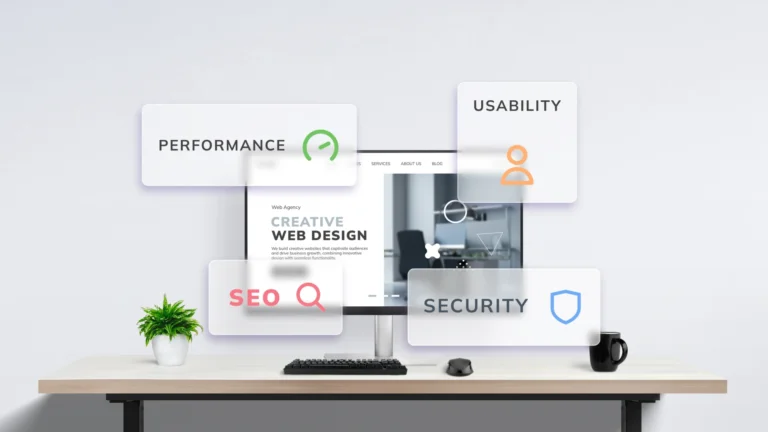So you want to know how to start a web design business. I won’t pretend it’s easy, but I can help make it a little more attainable by giving you some tips that I learned while building my own web design agency from the ground up over a decade ago.
In this guide, I’ll give you comprehensive advice on gaining web design skills, building your web design portfolio, finding new clients, and growing your business long-term.
Build websites to hone your skills
Before you start taking on projects and asking for money, you should build your skills and experience in web design. If you’re starting a web design agency, it’s highly likely you already know a lot about making websites.
However, the process of learning to create websites is very different from running a business where you get paid to make websites.
I’m sure you’ve heard it a million times, but I’ll say it again: practice makes perfect. I suggest you hone your web design skills by completing these three types of websites:
Develop your web design agency website
As a web designer, you’re a few steps ahead of most new business owners – you don’t have to pay someone to make your professional website!
Not only do you save a significant amount of money, but you also get to tailor your site to your needs and preferences without having to explain it to someone else.
Essentially, your business website is an advertisement of your skills for potential clients. When someone visits your site, you want them to be impressed with the quality and be willing to pay for a website like yours.
Put yourself in your clients’ shoes; would you buy a business website from a designer whose own site is visually unappealing, slow, or sloppy?
Probably not.
You should make sure your site reflects the results you promise to deliver: an error-free, attractive, and functional website.
Build microsites
Microsites are a relatively simple type of website to build, so you can practice your web design abilities without spending as much time and effort as you would with a full site.
Also, knowing how to make microsites will help you get more clients!
The purpose of a microsite is to promote a specific product, service, event, or campaign. Microsites usually have a different domain or subdomain than the main business website, but they include links back to the main site.
If you can build a solid microsite that effectively engages customers, you’ll be able to get more business from companies that want to buy promotional websites for their marketing campaigns.
Offer to make free websites for friends and family
If you’re a budding web designer, it’s likely you haven’t worked on a project that wasn’t for yourself or a course assignment. I believe it helps to get in a practice run before you try the real thing.
Offering to build a free website for a friend or family member can give you an idea of what it’s like to work with clients, including the process of communicating and understanding their needs.
For example, your friend might be an aspiring jewelry maker who needs an online store that attracts customers and helps her get more sales. You’ll have to consult her about the site and discuss the design and functionality she needs and go through the whole process from planning to launching the site.
It might seem like a lot of work to do without making money, but it’s a good way to get a taste of the true experience without the pressure of having deadlines and payment on the line.
Develop your portfolio
A part of learning how to start a web design business is developing a portfolio.
You need examples of your work to show prospective clients why they should hire you and that you can back up the skills you’re selling, so your next step should be to build your web design portfolio.
You can do this a few ways, but you should remember that the sites you highlight in your portfolio will determine the type of work you’re most likely to get.
If you show off five e-commerce sites and nothing else, you might be limiting yourself to clients who want online stores.
It’s fine to have a niche but keep in mind that greater variety in your portfolio widens your pool of potential clients. If you want to build certain types of websites, most of your examples should be the types that attract your target audience.
Reach out to local businesses
Okay, now you have some experience making different types of sites. You can start looking for actual clients in your community to help you gain professional examples to show off on your agency site.
These clients could be local businesses, such as restaurants, construction companies, bookstores, etc.
However, it’s crucial to be upfront with what your goal is when approaching business owners. Let them know you’re starting a web design company and you want to gain experience.
They should know what they’re agreeing to pay for, and being transparent will help you build solid business relationships from the start.
Give them a hefty discount (but don’t do it for free!)
You’re done making websites for free – you need professional experience to showcase in your portfolio, as in real business sites that your potential clients can visit themselves.
However, you shouldn’t charge too much right off the bat. This is your first experience as a professional web designer, so it makes sense to charge less than an established agency would.
As you gain experience and get more successful projects under your belt, your skills will grow, and so will your prices.
For now, your goal is to get work that you can show on your website to prove your web design proficiency.
Cultivate your business skills
While you’re not making as much cash on these jobs, they’re extremely valuable for a reason you might not have realized.
While creating these business sites for your portfolio, you’re building your skills as a professional, including:
- Project management
- Client communication
- Payments and billing
- Organization and productivity
You could be a web design master, but you won’t get very far without the skills needed to run a business, communicate with clients, and effectively manage a web design project from start to finish.
Add the completed projects to your agency website
You should aim to add at least five or six examples of your past web design projects. While your current portfolio might not reflect the types of sites you really want to make, you can add and remove examples to fine-tune your image as you complete more projects.
Your portfolio should be very easy to locate on your website, ensuring your prospective clients can quickly review your work. If they have to hunt down the link to your portfolio, they might give up and check the next site on their list.
In my professional opinion, it makes a huge difference to provide a brief overview of each project in your portfolio. It makes you look more credible and gives you a chance to show off your accomplishments.
Actively look for clients
At this point, you have a professional website and a well-crafted portfolio, so you can begin looking for new clients in earnest.
Considering you can design websites from anywhere, you don’t have to limit your target audience to businesses in your area. This advantage gives you a lot of options to find clients, even before your marketing is in full swing.
I recommend new web designers try these tactics to find new clients:
Contact business owners you know
When you’re just starting out as a web designer, your best resource is your personal network.
You’ve already worked with a few business owners; don’t be afraid to reach out to them to see if they’re interested in your services for another project.
Perhaps you have friends from school that started small businesses or a family member that owns a company. Give them a call or send an email with a link to your site so they can see what services you offer and your past work.
Talk to your friends who know business owners
In the same vein as the previous tip, you should get in touch with people who know business owners. See if they’re willing to pass on your contact information, including your website, to the potential client and any other business owners they know.
While the business owner might not need web design services at the moment, it’s likely they will in the future, and they’ll already have your contact info.
You could contact them directly, but people typically trust referrals from friends or family more than sales pitches from strangers.
Cold approach businesses
While getting a referral is ideal, that doesn’t mean you shouldn’t try cold calling, emailing, or walking into businesses that might need your web design expertise.
However, you shouldn’t go in blind. Be sure to research the business, including their brand, products or services, and existing website. If their website is slow and clunky, you can prepare a strategy to propose to the owner when you talk to them.
This method can take some time, but it’s a great way to find new clients while your agency is still in its infancy.
Work on long-term business goals
As your web design agency starts to get on its feet and you begin getting paid clients, you should be establishing some long-term objectives to grow your business, such as building up your inbound marketing and acquiring new skills for your repertoire.
You can attract new clients in so many ways, but the following are tasks I suggest you focus on first:
Develop SEO content for your site
If you want clients to find you organically, you need to work on search engine optimization (SEO) for your site. You’ll create high-quality, informative content containing keywords related to the web design services you offer, such as:
- Web development
- Marketing
- Social media
- Website redesign
SEO helps your web agency site rank higher in the search results of people searching for web design services, allowing you to get more traffic and new clients.
If you want Google to give your site a good ranking, you have to make the search engine like your website.
You can accomplish this by doing the following:
- Learn how to use common SEO tools
- Create content valuable to readers
- Place keywords strategically and naturally
- Optimize meta tags, headings, etc.
- Include high-quality internal and external links
- Ensure your site has an excellent user experience
Developing SEO for your site is time-consuming, but you’ll learn a valuable skill in the process that you can now offer to your clients. Using SEO best practices when building a client’s business website will help you deliver a finished product that not only looks and runs flawlessly but also brings in organic traffic.
Set up your business profiles
Your online presence is critical, so don’t put off making your business profile on sites like Google, Facebook, and Yelp.
Setting up these profiles makes it much easier for your clients to find your agency and get a quick overview of essential information like your contact details, business hours, and location.
These profiles also include your client reviews, helping users find out what it’s like to work with your agency and the quality of work you deliver. At the end of projects, you should always request that your client leave a review so you can collect plenty of positive feedback to show prospective clients.
Your “Google My Business” profile is crucial to have, but it’s up to you whether you think you need a Facebook or Yelp page since they’re typically geared toward local users.
Get active on social media
Another super important part of building your online presence is getting on social media. You need to go where your audience is, so pinpoint which social media platforms are the most valuable for your business, whether it’s LinkedIn, Twitter, or Instagram.
You can find social media communities that help you connect with business owners or other web designers that can refer clients looking for your niche skills.
You’ll also want to post regularly, so your business seems active, providing informative, entertaining, or helpful content for your followers. Social media gives you an opportunity to bond with your target audience, creating stronger relationships that lead to more work.
Additionally, learning social media content management allows you to add it to your list of services, opening your business up to even more types of clients.
You’ll use the same strategies for your clients’ businesses that you used to market your own agency.
Shape your brand
If you want your web design agency to be recognizable and memorable to your target audience, you need to establish your brand identity. To build your unique brand, you’ll need the following:
- Logo
- Brand color palette
- Distinct voice/personality
- Tagline
- Art/design style
While developing your brand, you should create a style guide for your agency, giving you a reference to look back on when creating content for your business in the future. Having these rules in place ensures you have a consistent message and identity no matter what platform you’re posting on.
Just like you did after learning social media and SEO for your own agency, you can start offering branding to your clients. Cultivating various web development and marketing skills enables you to offer complementary services and attract bigger projects.
You’ll research their business, including its target audience and the products and services it offers, then use that data to create an engaging brand that their customers will love.
As your brand image becomes more and more clear, you can additionally begin to implement core values and ideas into your branding, products, and more.
Learn Google Ads
Once you have a little cash flow going, you should invest in learning Google Ads. It’s the grand auction house of advertising that every business uses to ensure their website is at the top of the search results for the keyword searches that are relevant to their products.
In other words, businesses bid on keywords like “painting company in St. Louis” or “online dog training videos,” and Google shows the ad of the highest bidder.
It can take a lot of time to learn how to use Google Ads effectively, but it’ll be extremely worth it. Not only does it help you get more clients for your web design agency, but it also allows you to run ad campaigns for your clients.
If you can become an expert in Google Ads, you’ll be able to get much bigger clients and start making a significant return.
Final thoughts on starting a web design agency
Hopefully, this article has served as a helpful guide on how to start a web design business. It takes a serious commitment and plenty of courage, even as your company grows and you run into different problems and complications entirely, but I know from experience that it’s worth it if you really love web design.
My advice to you is to have patience and don’t feel discouraged if your business doesn’t immediately take off. Work hard toward your goals, remember to take breaks, and don’t get ahead of yourself.
Eventually, all the effort you put into building your business will come to fruition, and you’ll be the professional web designer you’ve dreamed of being!


















